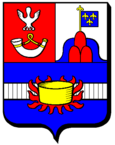Goetzenbruck
| Goetzenbruck | ||
|---|---|---|

|
|
|
| region | Grand Est | |
| Department | Moselle | |
| Arrondissement | Sarreguemines | |
| Canton | Bitche | |
| Community association | Pays de Bitche | |
| Coordinates | 48 ° 59 ′ N , 7 ° 23 ′ E | |
| height | 260-432 m | |
| surface | 8.12 km 2 | |
| Residents | 1,531 (January 1, 2017) | |
| Population density | 189 inhabitants / km 2 | |
| Post Code | 57620 | |
| INSEE code | 57250 | |
 View from the church tower |
||
Goetzenbruck ( German Götzenbrück , Lorraine. Getzebrikk ) is a French commune with 1531 inhabitants (as of January 1, 2017) in the Moselle department in the Grand Est region (until 2015 Lorraine ). It belongs to the Sarreguemines arrondissement and the Bitche canton and is part of the cross-border Palatinate Forest-Northern Vosges biosphere reserve .
geography
Goetzenbruck is located in the south of Bitscher Land on the edge of a high plateau. The Moderbach flows to the west and the Breidenbach to the east. Goetzenbruck has a share in the Northern Vosges Nature Park . The demarcation takes a complicated course. In the south, the Alsatian canton of Ingwiller is only a stone's throw away, but separated by a narrow strip of the Meisenthal district , in the east the district of Münzthal connects and in the north for a short stretch of Lemberg . In the east, the border to the neighboring village of Mouterhouse, which is hidden deep in the Vosges forests , runs with several projections and recesses. The district of Saareinsberg adjoins immediately to the east, the district of Althorn is located in the southeasternmost corner of the district.
history
Goetzenbruck was founded as Gotzbruck in 1721 by the glassmaker Jean-Baptiste Poncet from Meisenthal. The name should be traced back to a bridge figure. Duke Leopold of Lorraine bequeathed the wood-rich area to the glassmakers in order to be able to develop their expanding, important industry for the duchy. From February 6, 1945 to the end of March 1945, the population was evacuated to Crooked Alsace and the municipal administration was temporarily relocated to Bistroff . After the place had been liberated by the US Army on December 6, 1944 , heavy bombing raids had occurred over and over again in the months that followed. - The district Althorn was first mentioned as Horone in 873 . It belonged to the Weißenburg monastery . The place later fell desolate and was repopulated around the old chapel after the Thirty Years War . There used to be a castle of the Dukes of Lorraine here. - The current district of Saareinsberg, directly adjacent to Goetzenbruck, was founded in 1746 under the name Mont-Royal . Due to its geographical location on the watershed between the Rhine and Saar , Mont-Royal was renamed Saar-Rheins-Berg in 1793 . Like Althorn, it has only been part of Goetzenbruck since 1946. Both settlements were previously assigned to Mouterhouse. - Politically, Goetzenbruck belonged from 1790 to the canton of Lemberg, which no longer exists today, and from 1802 to the canton of Bitche.
Population development
| year | 1962 | 1968 | 1975 | 1982 | 1990 | 1999 | 2007 | 2017 |
| Residents | 1905 | 1979 | 1899 | 1759 | 1720 | 1751 | 1708 | 1531 |
Economy and Transport
economy
Goetzenbruck emerged from glassmaking , which still plays a dominant economic role today. In 1721 Jean-Georges Poncet, glassmaker from Meisenthal, received Wald an der Götzenbrücke from the Duke of Lorraine in order to set up a new factory here. Early on, the company specialized in the manufacture of watch glass, but in the 19th century glass statuettes of the Holy Virgin and Child were also a bestseller. Since 1925, the focus has been on the manufacture of spectacle lenses. Even then, high-quality special lenses were also manufactured for industrial and laboratory use. The latter are the most important products that are manufactured at the Goetzenbruck site of Sola Industries Optiques today.
traffic
Goetzenbruck is located on Départementalstrasse 37 Bitche - Wimmenau (- Ingwiller ).
Culture and sights
Croix de guerre (War Cross) in memory of the Second World War. - The facilities of the glass factory from 1721. - The glassmaker's chapel north of the factory. The first building was built in 1724 for the glass factory workers. In 1807 the factory owners initiated a restoration. In 1978 the chapel was finally added to the list of national cultural assets and saved from total ruin. The single-nave chapel is architecturally in the tradition of church building in Bitscher Land. The choir is polygonal. - Neo-Gothic Church of the Visitation . With the flourishing of the place through the glass industry and the associated population growth, Goetzenbruck, which previously belonged to Soucht , became an independent parish in 1802. Since the small chapel was no longer sufficient, a large church was built between 1863 and 1866, which has dominated the village ever since. Architect Desganges from Saargemünd was inspired by the Gothic of the 13th century, which is reflected in the large, filigree rose window above the west portal. - Numerous town houses from the beginning of the 19th century on the north-south main axis, including the former post office from 1789.
